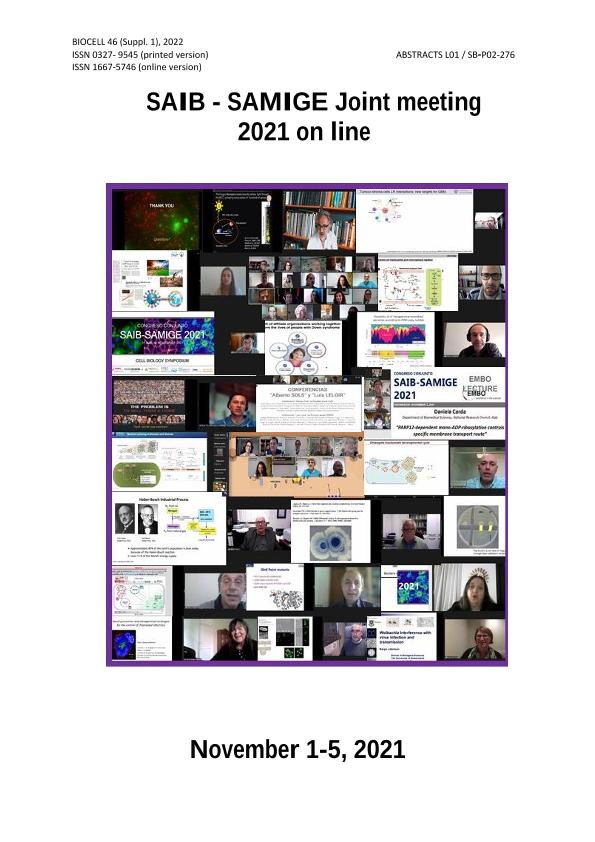Mostrar el registro sencillo del ítem
dc.contributor.author
Sacur, Jacinto Alfredo

dc.contributor.author
Matias Brancher, Julia Rafaela

dc.contributor.author
Raya Tonetti, María Fernanda

dc.contributor.author
Villena, Julio Cesar

dc.contributor.author
Vizoso Pinto, María Guadalupe

dc.date.available
2022-05-30T10:49:28Z
dc.date.issued
2022
dc.identifier.citation
An improved customized destination vector for heterologous expression of lysm fusionl proteins and antigen display on bacterium like particles; LVII Annual Meeting of the Argentine Society for Biochemistry and Molecular Biology Research (SAIB) and XVI Annual Meeting of the Argentinean Society for General Microbiology (SAMIGE); Argentina; 2021; 181-181
dc.identifier.issn
0327-9545
dc.identifier.uri
http://hdl.handle.net/11336/158445
dc.description.abstract
The LysM (lysin motif) domain is a small globular domain of 42-65 amino acids long that is widely distributed in nature, it can be found in procaryotes and eucaryotes in more than 4000 proteins. One to 12 LysM domains bind to N-acetylglucosamine residues of bacterial peptidoglycan (PG) in a non-covalently way. The binding between proteins with LysM domains and PG is strong and stable; it can only be separated under harsh reducing conditions. This can be useful for antigen display on the surface of bacterial PG for immunization purposes. It has been reported that the number of LysM motifs in proteins affects the efficiency of the binding of foreign proteins to the PG. Proteins with LysM domains can be difficult to express in a heterologous system like E. coli because of their size. It is known that proteins with LysM domains tend to aggregate and form inclusion bodies (IB). Previously our laboratory constructed a customized expression vector with 5 LysM domains from a protein (Acglu) of Limosilactobacillus fermentum, which has not been described before. We cloned ORF68, the main antigenic glycoprotein from the Varicella-Zoster Virus (VZV) without the transmembrane domain, into this vector but the fusion protein did not express in E. coli, possibly because of its size (94kDa) or its insoluble nature. Therefore, we decided to construct a new vector with only 2 of the 5 LysM domains from Acglu of L. fermentum. We constructed the expression vector pET-NHis-LysM2 [rfB] and checked it by Next Generation Sequencing. The vector has 2 LysM domains as a N-terminal tag for binding to bacterial PG and is a so-called destination vector compatible with Gateway® cloning technology. It also has the tag RGS-His, which allows protein purification. We cloned VZV ORF68 into this new vector using the Gateway® LR reaction. The fusion protein LysM2-ORF68 was expressed in soluble form, although most of the protein aggregates and forms IB. We optimized the protein expression trying different conditions, even though it always formed IB. Using chaotropic agents, like urea, we could solubilize the aggregated protein and purify it in successive steps. The LysM2-VZVORF68 protein both soluble and recovered from IB, binds to the PG of Gram-positive bacteria. To enhance binding, we exposed the PG shield by treating lactobacilli with acid and heat. The structure of a LysM domain consists of a pair of antiparallel beta strands separated by a pair of short alpha helices. Considering that the binding of LysM domains to PG depends on the native folding of the protein, we can infer that the fusion protein retains its normal folding even after the treatment with chaotropic agents. Further studies are necessary regarding stability of the binding, but we can speculate this new expression vector is promising for the heterologous expression and purification of viral proteins as well as for antigen display on immunomodulatory lactobacilli without generating genetically modified organisms.
dc.format
application/pdf
dc.language.iso
eng
dc.publisher
Tech Science Press

dc.rights
info:eu-repo/semantics/openAccess
dc.rights.uri
https://creativecommons.org/licenses/by-nc-sa/2.5/ar/
dc.subject
MUCOSAL VACCINES
dc.subject
VARICELLA ZOSTER VIRUS
dc.subject
BACTERIUM LIKE PARTICLES
dc.subject.classification
Enfermedades Infecciosas

dc.subject.classification
Ciencias de la Salud

dc.subject.classification
CIENCIAS MÉDICAS Y DE LA SALUD

dc.title
An improved customized destination vector for heterologous expression of lysm fusionl proteins and antigen display on bacterium like particles
dc.type
info:eu-repo/semantics/publishedVersion
dc.type
info:eu-repo/semantics/conferenceObject
dc.type
info:ar-repo/semantics/documento de conferencia
dc.date.updated
2022-05-10T14:36:10Z
dc.identifier.eissn
1667-5746
dc.journal.volume
46
dc.journal.number
Suppl. 1
dc.journal.pagination
181-181
dc.journal.pais
Estados Unidos

dc.journal.ciudad
Henderson
dc.description.fil
Fil: Sacur, Jacinto Alfredo. Consejo Nacional de Investigaciones Científicas y Técnicas. Centro Científico Tecnológico Conicet Noa Sur. Instituto Superior de Investigaciones Biológicas. Grupo de Investigación y Desarrollo del Noroeste Argentino | Universidad Nacional de Tucumán. Instituto Superior de Investigaciones Biológicas. Grupo de Investigación y Desarrollo del Noroeste Argentino; Argentina. Universidad Nacional de Tucumán. Facultad de Medicina; Argentina
dc.description.fil
Fil: Matias Brancher, Julia Rafaela. Consejo Nacional de Investigaciones Científicas y Técnicas. Centro Científico Tecnológico Conicet Noa Sur. Instituto Superior de Investigaciones Biológicas. Grupo de Investigación y Desarrollo del Noroeste Argentino | Universidad Nacional de Tucumán. Instituto Superior de Investigaciones Biológicas. Grupo de Investigación y Desarrollo del Noroeste Argentino; Argentina. Universidad Nacional de Tucumán. Facultad de Medicina; Argentina
dc.description.fil
Fil: Raya Tonetti, María Fernanda. Consejo Nacional de Investigaciones Científicas y Técnicas. Centro Científico Tecnológico Conicet Noa Sur. Instituto Superior de Investigaciones Biológicas. Grupo de Investigación y Desarrollo del Noroeste Argentino | Universidad Nacional de Tucumán. Instituto Superior de Investigaciones Biológicas. Grupo de Investigación y Desarrollo del Noroeste Argentino; Argentina. Universidad Nacional de Tucumán. Facultad de Medicina; Argentina
dc.description.fil
Fil: Villena, Julio Cesar. Consejo Nacional de Investigaciones Científicas y Técnicas. Centro Científico Tecnológico Conicet - Tucumán. Centro de Referencia para Lactobacilos; Argentina
dc.description.fil
Fil: Vizoso Pinto, María Guadalupe. Consejo Nacional de Investigaciones Científicas y Técnicas. Centro Científico Tecnológico Conicet Noa Sur. Instituto Superior de Investigaciones Biológicas. Grupo de Investigación y Desarrollo del Noroeste Argentino | Universidad Nacional de Tucumán. Instituto Superior de Investigaciones Biológicas. Grupo de Investigación y Desarrollo del Noroeste Argentino; Argentina. Universidad Nacional de Tucumán. Facultad de Medicina; Argentina
dc.relation.alternativeid
info:eu-repo/semantics/altIdentifier/url/http://www.saib.org.ar/sites/default/files/TSP_BIOCELL_46213-SAIB-SAMIGE%202021.pdf
dc.conicet.rol
Autor

dc.conicet.rol
Autor

dc.conicet.rol
Autor

dc.conicet.rol
Autor

dc.conicet.rol
Autor

dc.coverage
Internacional
dc.type.subtype
Reunión
dc.description.nombreEvento
LVII Annual Meeting of the Argentine Society for Biochemistry and Molecular Biology Research (SAIB) and XVI Annual Meeting of the Argentinean Society for General Microbiology (SAMIGE)
dc.date.evento
2021-11-01
dc.description.paisEvento
Argentina

dc.type.publicacion
Journal
dc.description.institucionOrganizadora
Sociedad Argentina de Investigación en Bioquímica y Biología Molecular
dc.description.institucionOrganizadora
Sociedad Argentina de Microbiología General
dc.source.revista
Biocell

dc.date.eventoHasta
2021-11-05
dc.type
Reunión
Archivos asociados
